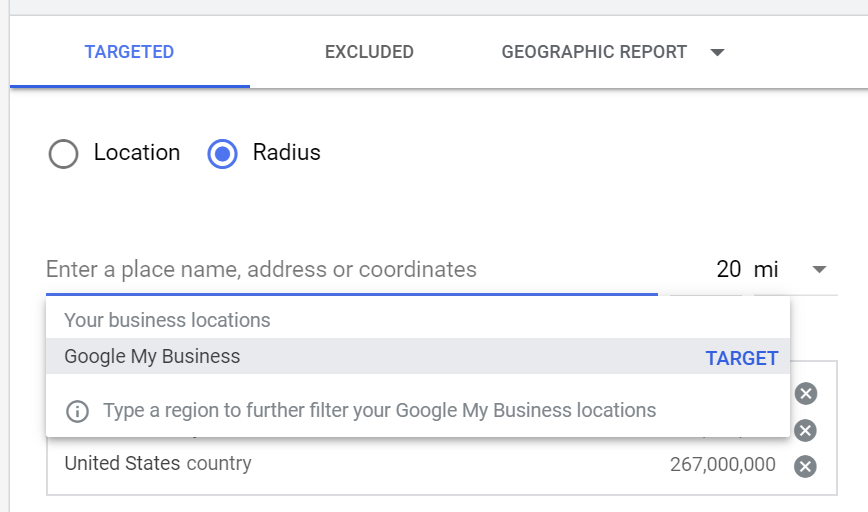Location-based advertising is an essential strategy for businesses large and small. Whether you operate locally or on a global scale, advanced geo-targeting in Google Ads offers powerful tools to hone in on your target audience.
From pinpointed location targeting to strategic location exclusions and local inventory ads, Google Ads can help you maximize your budget and boost ROI by reaching the most relevant customers.
Are you ready to get more return from your Google Ads campaigns? Read on as we review the advanced geo-targeting strategies you should be using.
Sections
Leverage location targeting to reach your ideal audience
Location targeting allows businesses to define the geographic areas where your ads should be shown. With Google Ads, you can choose to target countries, regions, cities, or even a specific radius around a location.
For businesses with a physical presence, local targeting within a certain radius can help attract nearby customers likely to visit. For example, a pizza restaurant could target people within a 5-mile radius of their Google Business Profile, while excluding other locations to reduce ad spend wastage.

For international brands, targeting multiple countries with location-specific ads ensures that users in different areas see content tailored to them. Language differences, cultural nuances, and even time zone-specific promotions can be set up to cater to these diverse audiences, maximizing global reach while ensuring your ads stay relevant.
Optimize results with location exclusions
While location targeting helps you find potential customers, location exclusions allow you to avoid unprofitable or irrelevant areas. For example, a roofing company operating solely in Southern California could exclude other California regions and other states to focus solely on local prospects. Excluding areas can reduce wasted ad spend on clicks from users who live outside your service areas.
Location exclusions are also useful for global campaigns. If a brand sells in Europe but not the United States , excluding the U.S. ensures that their budget is reserved only for potential customers.
Businesses with more precise exclusion criteria can even drill down to neighborhoods or postal codes, minimizing interactions with low-value locations and reaching customers more efficiently.
Use local inventory ads to drive foot traffic
For brick-and-mortar retail stores, local inventory ads are an ideal solution for showcasing products to nearby shoppers. If the customer is ready to make a purchase, seeing that they can buy locally rather than wait for delivery can be a strong incentive.
Local inventory ads display your products and indicate that they’re available in a nearby store, attracting users who want to make an in-store purchase. You can enhance your local inventory ads by highlighting your Buy Online, Pickup In Store (BOPIS) availability, current prices, and more.
Target seasonal and event-based locations
For businesses whose sales peak during certain seasons or events, Google Ads also allows event-based geo-targeting.
For example, a hotel chain can target visitors in key vacation hotspots during the summer, or around special events like music festivals and conferences. By adjusting your ad parameters to target event-heavy locations during peak times, you can maximize the relevance of your ads and increase the chance of conversions.
To implement seasonal geo-targeting, start by analyzing your past traffic patterns and booking dates. This can help you determine when and where to increase bids or show event-based ads. Setting up custom location lists in Google Ads allows you to build targeted campaigns quickly each season, driving cost-effective, high-relevance traffic.
Tap into demographic insights with geo-based demographics
With advanced geo-targeting in Google Ads, you can refine your campaigns further by layering in location-based demographics. These insights let you adapt messaging for different groups within a location, appealing to specific demographics that may drive better results.
For example, a financial services firm may see higher conversions by targeting affluent neighborhoods with tailored ads about their premium services.
By combining geo-based demographics with location targeting, businesses can make their ads more personalized and relevant. It’s smart to A/B test your ads for different demographic segments within the same location. This helps optimize your campaigns over time and ensure you’re reaching the most engaged audience with the most effective messaging.
Get started with geo-targeting today
With advanced geo-targeting in Google Ads, businesses can refine their strategies to focus only on the most valuable customers. By leveraging precise location targeting, exclusions, and local inventory ads, you can boost your ad relevance and drive better results.
Whether you’re a local business looking to capture nearby customers or a global brand optimizing campaigns across countries, using advanced geo-targeting can transform your advertising strategy for maximum efficiency and impact.
Ready to get started? Contact Your Marketing People today to discover how advanced geo-targeting strategies can improve the performance of your Google Ads campaigns.







